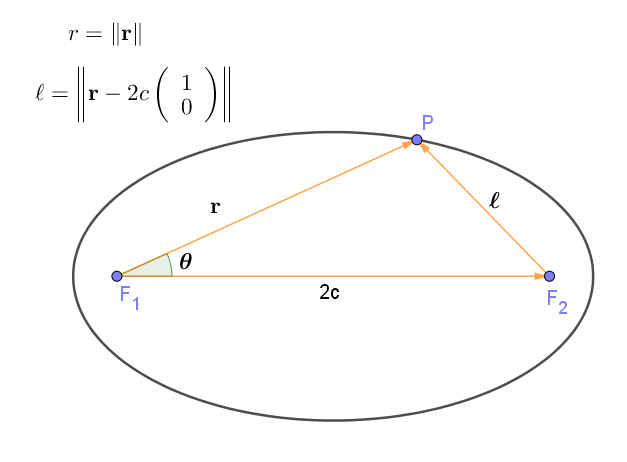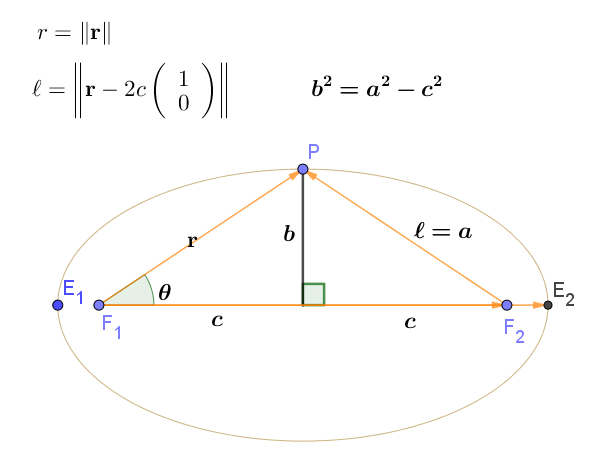Polar Derivation of an Ellipse
We will show that an ellipse with one focus at the origin can be written in polar coordinates as $$r(\theta)=\frac{\frac{b^{2}}{a}}{1-\frac{c}{a}\cdot cos(\theta)}$$ where $a$ is the semi-major axis, $b$ is the semi-minor axis, $c$ is half of the distance between foci, and $r$ and $\theta$ are the magnitude and angle from the origin to any point on the ellipse.

Begin with focal points, $F_{1}$ and $F_{2}$ and an arbitrary point, $P$ somewhere on the elliptic curve. For convenience, put $F_{1}$ at the origin and let $a$ be the semi-major axis length. From the definition of the curve write, $$\Vert P-F_{1}\Vert+\Vert P-F_{2}\Vert=2a \tag{1} \label{1}$$ Then we get the graph shown in figure 1. The goal of any polar derivation is to develop an equation in $r$ and $\theta$ and then solve it for $r$.
Since $F_{1}$ is at the origin, vector $\mathbf{r}$ which in the figure terminates at point $P$ is $$\mathbf{r}=\left(\begin{array}{c} r\cdot cos(\theta)\\ r\cdot sin(\theta) \end{array}\right)$$ So equation $\eqref{1}$ can become $$\mathbf{\Vert r}-F_{1}\Vert+\Vert\mathbf{r}-F_{2}\Vert=2a$$ and when we expand the vectors, $$\left\Vert \left(\begin{array}{c} r\cdot cos(\theta)\\ r\cdot sin(\theta) \end{array}\right)-\left(\begin{array}{c} 0\\ 0 \end{array}\right)\right\Vert +\left\Vert \left(\begin{array}{c} r\cdot cos(\theta)\\ r\cdot sin(\theta) \end{array}\right)-\left(\begin{array}{c} 2c\\ 0 \end{array}\right)\right\Vert =2a \tag{2} \label{2}$$ Since the length of vector $\mathbf{r}=r$, \eqref{2} can be written as $$r+\left\Vert \left(\begin{array}{c} r\cdot cos(\theta)\\ r\cdot sin(\theta) \end{array}\right)-\left(\begin{array}{c} 2c\\ 0 \end{array}\right)\right\Vert =2a \tag{3} \label{3}$$ Using algebra we can rearrange $\eqref{3}$ to get $$r-2a=-\left\Vert \left(\begin{array}{c} r\cdot cos(\theta)\\ r\cdot sin(\theta) \end{array}\right)-\left(\begin{array}{c} 2c\\ 0 \end{array}\right)\right\Vert . \tag{4} \label{4}$$ Expanding the right side, $$\begin{aligned} r-2a&=-\sqrt{\left(r\cdot cos(\theta)-2c\right)^{2}+\left(r\cdot sin(\theta)-0\right)^{2}}\\ &=-\sqrt{r^{2}cos^{2}(\theta)-4rc\cdot cos(\theta)+4c^{2}+r^{2}sin^{2}(\theta)}\\ &=-\sqrt{r^{2}-4cr\cdot cos(\theta)+4c^{2}} \end{aligned} \tag{5} \label{5} $$ Then squaring both sides, $$r^{2}-4ar+4a^{2}=r^{2}-4cr\cdot cos(\theta)+4c^{2} \tag{6} \label{6}$$ From \eqref{6} it is simple algebra to solve for $r$ as a function of some constants and $\theta$. $$r(\theta)=\frac{a^{2}-c^{2}}{a-c\cdot cos(\theta)} \tag{7} \label{7}$$

As shown in figure 2, the semi-minor axis, $b$, can be derived from a Pythagorean relation such that $b^{2}=a^{2}-c^{2}$. We actually have that in the numerator of $\eqref{7}$, which allows the use of the semi-minor axis length in the equation. $$r(\theta)=\frac{b^{2}}{a-c\cdot cos(\theta)} \tag{8} \label{8}$$ We can multiply $\eqref{8}$ by $(1/a)$ in both numerator and denominator to get $$r(\theta)=\frac{\frac{b^{2}}{a}}{1-\frac{c}{a}\cdot cos(\theta)} \tag{9} \label{9}$$ the later being done so as to define eccentricity and “parameter p” and perform a substitution. $$eccentricity=\mathrm{e}=\frac{c}{a}$$ $$parameter=p=\frac{b^{2}}{a}$$ $$r(\theta)=\frac{p}{1-\mathrm{e}\cdot\cos(\theta)} \tag{10} \label{10}$$